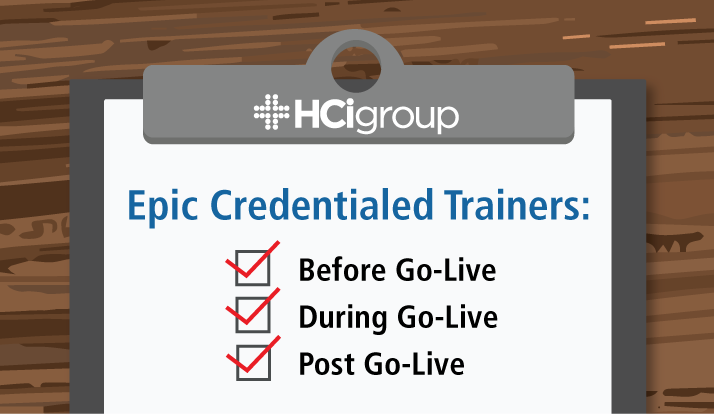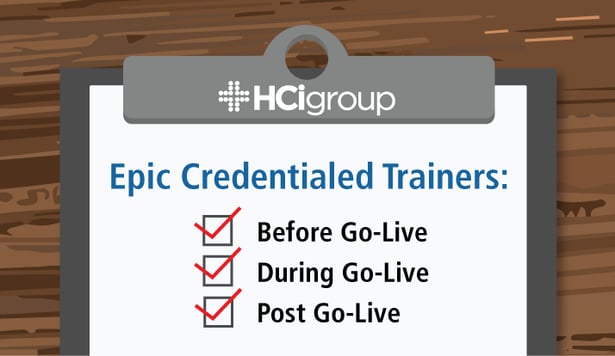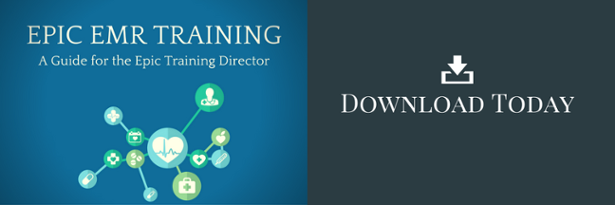Epic Credentialed Trainers: Before, During & Post Go-Live


Editors Note: This post was originally published in September 2013 and has been updated for accuracy and comprehensiveness.
An Epic Implementation takes a team effort—it is important to remember that everyone has their own crucial role. For example, C-level management will have to make strategic and difficult decisions. The testing leads will also have their hands full. However, when it is time for your Epic Go-Live, everyone will be working together to ensure that it is successful. In this post, we touch on one of the most underrated elements of any implementation: the Epic credentialed trainer. Most likely, your organization has at least a few credentialed trainers on staff to run training sessions. However, much of their value comes from activities other than just teaching classes. It is important to utilize credentialed trainers to their full potential, as they are such valuable resources pre and post go-live.
There are three areas in which an Epic credentialed trainer can profoundly benefit your organization’s implementation:
1) Pre Epic Go-Live Support
Before your Epic go-live, credentialed trainers have one obvious responsibility: to teach training classes and keep the instructional designer from working around the clock. However, they can also add value in a variety of ways. An experienced CT can be a valuable asset during the preparations for training. All of the training environments for each application must be completed in advance of the Go-Live to provide a place for users to work during classes. Frequently, however, there are several steps involved in the preparations, for example: setting up labs to send results automatically or dropping charges on patients used as training cases for users. Since these steps are time and order-sensitive, they must be done correctly the first time. Improper execution may set an application back for days, which can result in major headaches as the project unfolds.
Additionally, there is a vast amount of classroom material that will need to be created. Quick start guides, training companions, tent cards, and barcodes are examples of materials that are typically utilized. It can be a challenge for instructional designers to create and manage all of these materials, so having an experienced set of hands to assist will pay dividends. Poor quick start guides or tent cards can be substantially detrimental to training, as any time wasted in class will likely have a negative impact on the attitudes of your students and the perceived success of the implementation. If training is a mess, what should end users expect at the Go-Live? Similarly, if your credentialed trainers are not strong in the classroom, it can negatively impact end user buy-in and long-term success. Making sure that the CTs are brought in early ensures a smoother learning experience, which not only builds goodwill, but instills good habits and end user preparedness.
2) During Epic Go-Live
It’s tempting to think that once the Go-Live begins the work of a CT might be complete; successful organizations will know this is not the case. Actually, it's quite the contrary - during go-live is when CTs can truly shine. By placing them on the floor as end user support, end users have access to someone who taught them in class and has in-depth knowledge of the system. Questions are answered, workflows are performed properly, and the system is being utilized to the highest degree. Super users will still be an excellent resource. However, confidence comes from end users knowing that what they are hearing is correct. This is reassuring to end users and will often ease tensions during this stressful time. Additionally, the project team will have a direct liaison to the floor who knows the system and can describe what is going on. While issue tickets are important, they are also an imperfect form of information. If the tickets are left unaddressed, end users may feel ignored and lose confidence in the project. This issue can be avoided by bringing information in directly from both IDs and CTs, which will spare the project team from direct visits. Additionally, this will give the team a greater amount of time to resolve additional issues.
3) Post Epic Go-Live Support
The importance of a good credentialed trainer does not stop once the system is up and running. When an organization decides to undergo an upgrade, refresher, optimization, or new hire training, there will be a need for classroom support from CTs. Asking instructional designers to handle these tasks without aid is not a feasible option and runs the risk of severely overworking them (the IDs will need more than a few hours of sleep per night). Furthermore, keeping CTs as extended Go-Live support for those who are struggling can help bring lagging users back up to speed. This shows the organization’s commitment to a complete transition and will help build goodwill with the rest of the staff as well. Also, there will be the added benefits of understanding which workflows need to be tweaked and which build pieces need improved functionality. Ultimately, all of this provides additional time for the project team to focus on carrying out necessary build and workflow adjustments.
Experienced credentialed trainers can be game changers when they are utilized for activities outside of classroom training. From training to post go-live, their roles as teacher and end user support help to ensure the overall success of an implementation. Though they often operate under the radar, it is unwise to overlook the additional value Epic credentialed trainers bring to the table.

